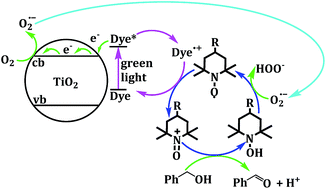Cooperative photocatalytic selective aerobic oxidation of alcohols on anatase TiO2†
Abstract
Organic transformations face tremendous challenges in order to circumvent the necessity of poisonous reagents and harsh reaction conditions. These can, in principle, be addressed by photocatalysis that can turn them into environmentally friendly alternatives. In particular, visible-light photocatalytic selective oxidation of alcohols is posed to be one of the most common organic transformations, but a hugely formidable one. In view of this, we exploited a cooperative photocatalytic system to realize the efficient selective oxidation of alcohols with molecular oxygen (O2). A halogen-free organic dye, 5(6)-carboxyfluorescein [5(6)-FAM], was selected to anchor onto TiO2 with 4-methoxy-2,2,6,6-tetramethylpiperidine1-oxyl (CH3O-TEMPO) as a cocatalyst. A series of control experiments, involving TEMPO and its derivatives, different solvents, initial alcohol concentrations, different light-emitting diodes (LEDs), and TiO2, were carried out to optimize the results of alcohol oxidation. Importantly, reactive oxygen species (ROS) quenching experiments, spectroscopic analyses (such as electron paramagnetic resonance (EPR) and UV-visible absorption spectra), and kinetic studies provide evidence to a plausible mechanism for the cooperative photocatalytic reaction. Our work suggests that 5(6)-FAM-sensitized TiO2 can be applied as an efficacious photocatalyst and CH3O-TEMPO is more effective as compared to TEMPO. This discovery may open up a new path to visible-light photocatalytic selective organic transformations under ambient conditions.

- This article is part of the themed collection: 2019 Sustainable Energy and Fuels HOT Articles


 Please wait while we load your content...
Please wait while we load your content...